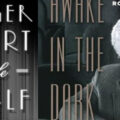A Ringing Echo: The Poetry of Caitlin Doyle
 Caitlin Doyle’s poems are not always what they appear to be, and this subtle shape-shifting quality is exactly what makes them so revelatory. As poet and critic Abriana Jette has written, Doyle’s work challenges “the belief that a poem that appears accessible of the surface is thus easy to comprehend… (her poems) always possess layers of complexity that reward multiple readings.” Whether using her inventive artistry to forge formal poetry or free verse, which she does with equal skill, Doyle creates poems that buzz with complicated nuances beneath their pared-down and haunting surfaces.
Caitlin Doyle’s poems are not always what they appear to be, and this subtle shape-shifting quality is exactly what makes them so revelatory. As poet and critic Abriana Jette has written, Doyle’s work challenges “the belief that a poem that appears accessible of the surface is thus easy to comprehend… (her poems) always possess layers of complexity that reward multiple readings.” Whether using her inventive artistry to forge formal poetry or free verse, which she does with equal skill, Doyle creates poems that buzz with complicated nuances beneath their pared-down and haunting surfaces.
Doyle and I crossed paths for years without ever actually meeting. Though we both received our graduate degrees from Boston University’s Master of Fine Arts Program, we attended in different years and studied different genres. Later, we were both invited back as Alumni readers at separate Annual Faculty Readings. Despite these similarities, I never came into contact with her, though I’d heard talk of her work for years. As her career began to blossom, I became more and more intrigued. Only once I’d been offered the Jack Kerouac House Writer-In-Residence position—the same position Doyle held a few years earlier—did I finally sit down and read her poems.
My only regret is that it took me so long.
What grabbed me first, as I began my journey into Doyle’s work, is her commitment to exploring both the limits and freedoms inherent in poetic form. Doyle has the unique ability to both adhere to and experiment with traditional formal properties, such as rhyme and meter, while shaping poems that simultaneously gesture toward poetic tradition and seek innovative new ground. As a novelist who has recently crossed into co-authoring and ghostwriting, I’ve often found myself pushing the boundaries of voice and genre with my fiction. While Doyle’s literary background, on the surface, couldn’t seem more different from my own—my forays into the highly commercial mass-media genre seem like the antithesis of her publication in numerous esteemed literary anthologies—I draw inspiration from the openness and risk-taking ingenuity with which she navigates the relationship between structure and content in her work.
Though she is still in the early stages, currently working on her first book-length poetry manuscript, Doyle has already attracted a degree of attention and critical engagement that is rare for a poet her age. Her poems have been discussed in essays and reviews by a variety of writers, and she has received prestigious fellowships, awards, writer-in-residence positions, and teaching posts around the country. With the plethora of MFA-laden poets struggling to gain an audience for their work, what is it about Doyle’s poetry that compels this kind of interest? Why had I felt that same magnetic pull within moments of reading the first poem?
Philip Larkin once wrote that the success of his poems ultimately rests with his readers, “who will in due course pass judgment by either forgetting or remembering them.” To read Doyle’s work is to discover a poet who shares Larkin’s emphasis on the role of memorability in poetry. She builds her poems in such a way that they seek space in the reader’s memory. As Abriana Jette has written, “Doyle’s devotion to musicality is the edifice of her poetry.” In her essay “Doyle & The Ersatz Life,” critic Michelle Lewis uses Doyle’s poem “The Bells” to discuss the sonic elements of her work. Lewis highlights “The Bells” for its “exquisitely rendered” sonic atmosphere, and she applauds Doyle’s use of language to create a visual landscape “full of mirror-images that blend together, Escher-like and unsettling.” Listen to these lines from the poem, which comprise the first two stanzas and the beginning of the third stanza:
The bells sit in the belfry upside down
until swung into speech, their common tongue
a language regular yet strangely wrung
free of familiars, void of any nounwe know. They speak reverb; no verb can make
them clear. Twelve knells for noon, but in the tower
the echo’s double-talk implies the hour
is not the hour, that it’s been a mistakefrom the beginning…
Doyle has been noted by Apostrophe Cast for the “remarkable breadth of technical skill” in her work, and various poets and critics have written about elements of her formal artistry. In the rhyming stanzas, the colloquial use of meter, and the merging of different dictions, “The Bells” embodies the technical prowess that distinguishes much of her work. The poem also exemplifies the sophisticated relationship Doyle forges between the structure and the subject matter of her work. Technical savvy and emotional content function in tandem, reflecting and playing off of each other.
As “The Bells” unfolds, the bells and their echo become a vehicle for examining the tension between religious faith and doubt. The poem’s abundant echoing—alliteration, internal rhymes, and end rhymes— underscores its themes. Doyle’s poem “Carnival” operates in a similar manner:
Pretty eyes, he said to you,
let’s get tickets
let’s get two
let’s get on the tilt-a-whirl
then watch the house of mirrors swirlPretty lips, he said to me,
let’s get tickets
let’s get three
let’s get on the zipper wheel
then watch the house of mirrors reelPretty here and pretty there!
Aren’t we such
a pretty pair?
Pick a pretty, make a pass
(just be careful of the glass)Pretty that and pretty this!
Come in closer
for a kiss
(now we’re double, now we’re half)
and watch the house of mirrors laugh.
The use of a nursery-rhyme tone captures the innocence of two young girls at a carnival. Yet beneath the whirling musicality, the reader grows aware of an impending darkness as the girls encounter an older male figure. On the surface, the piece offers a lighthearted playfulness, yet there is a disconcerting unrest just below. Doyle’s repetition of “house of mirrors” plunges us, both literally and figuratively, into a world where identity can be distorted. The girls in “Carnival,” as seen both in the male’s eyes and the fun-house mirror, have been transformed. They are no longer fully themselves, instead forcibly fragmented into a set of “pretty eyes” and “pretty lips,” a pair of images that “swirl” and “reel” in the glass.
In stanzas three and four, the girls exert a sudden, surprising power over both the poem and the male figure. In this haunting turn, they invite him into their house of mirrors, welcoming him into a new game of temptations and sleights. Though the girls finally elude the man’s grip, the reader realizes that this freedom comes with a price. The line “now we’re double, now we’re half” doesn’t just describe their physical distortions in the mirror house. The girls’ power, as objects of attraction, has both seemingly doubled their worth (in the eyes of the man and in their mirror reflections) and halved it.
In addition to formal rigor, readers find in “The Bells” and “Carnival” the work of a writer committed to exploring narrative elements. Michelle Aldredge of Gwarlingo has spoken about Doyle’s ingenuity when it comes to the narrative qualities of her work: “Although she is a poet and not a fiction writer, she shares Flannery O’Connor and Faulkner’s Southern-gothic flair for unsettling (sometimes comic) domestic scenes. The Bronte sisters, Isak Dinesen’s tales, and Christina Rossetti’s ‘Goblin Market’ also spring to mind, for in Doyle’s modern-day rhymes, there are most certainly goblins lurking in the forest and madwomen in the attic.”
Michelle Lewis highlights a central “dichotomy” in Doyle’s writing between the familiar and the alien. This tension, which Lewis describes as “reality on one side of the door” and “unreal counterpart on the other,” is Doyle’s fixation, “and for the reader, it is in the most satisfying sense, the unease that stalks our comfort.” These observations gesture toward the way that Doyle’s poems, almost always infused with a vivid clarity on the surface, bristle underneath with shadows, ironies, and paradoxes.
For all of Doyle’s skill with formal and narrative approaches to poetry, it’s important to emphasize that she escapes being solely defined as either a formal poet or a narrative poet. Her free verse poems are as frequent and finely wrought as those steeped in formal traditions, and some of her best poetry is decidedly more lyric or associative than narrative. Among her most gripping free verse works is “If Siegfried And Roy Had Never Met,” a poem about the Vegas performers Siegfried Fischbacher and Roy Horn. Michelle Lewis has written about the piece as a “darkly wonderful” work that “creates for the two performs an alternate reality.” Another free verse piece, “Self-Portrait With Monkeys,” leads readers on a haunting trek into the speaker’s inner landscape, the result of which can only be described as an eerie, yet playful, gut-punch to the reader.
Just as Doyle embraces a diversity of formal approaches, she has exhibited a noteworthy thematic adventurousness as well. She has written on topics as diverse as politics, pop culture, science, childhood, and love, and her pieces can range from searingly personal to wittily cerebral. In “The Doll Museum,” an understated poem about the death of a child, Doyle demonstrates her ability to deliver a resounding emotional impact. The poem’s speaker, who lost her sister to a childhood illness when they were both young, remembers the eerily lifelike quality of their dolls, laid out with price tags at a family yard sale: “…Even then they looked alive, / survivors with no sickness to survive.”
Doyle’s work also stands out for its skilled and unabashed use of wit and humor, which never feels forced or overly self-aware. Take, for example, this excerpt from “The Breakfast In Heidelberg Series:”
Said Fellini to Houdini
“Have you seen my martini?”
Said Bernini to Houdini
“Or my peach bellini?”
Said Houdini to Bernini and Fellini
“Your bellini? Your martini?
Can’t say that I have.”
Said Fellini and Bernini to Houdini
“We left them right here, Harry,
when we went to use the lav.
Don’t you think that’s weird?”
Said Houdini to Fellini and Bernini
“They must have disappeared.”
The unexpected, comical pairings that appear throughout the series—Fellini and Houdini, Brueghel and Hegel, Rimbaud and Rambo—offer surprising opportunities for humor. But there is more than fun wordplay at work here. As Abriana Jette has written, the poem comments on how the human mind, in this era of information overflow, processes history in an associative and tangled manner. Doyle’s humorous verse bubbles with serious implications that lie beneath the pleasurable qualities of its surface.
The majority of poetry journals today contain legions of poems that sound nothing like Doyle’s work. Poet and critic Amit Majmudar has written of the trend among large numbers of poets to write work steeped in “atomization of meaning from line to line” and the frequent use of “non sequitur or near-non sequitur,” as well as “the inclusion of (unlinked) discursive or assertive statements” and “abstractions.” As Majmudar says, “many young poets seem to write in this mode as well.” He goes on to cite the shaping influence of figures like John Ashbery, Dean Young, and Bob Hicok on young poets engaged in this mode.
Readers are more inclined to pick up in Doyle’s work echoes of figures such as Christina Rossetti, Edwin Arlington Robinson, W.H Auden, A.E Housman, Robert Frost, and Edna St. Vincent Millay. This isn’t to say, of course, that she is entirely alone among poets (both younger and older) in possessing aesthetic values that veer away from associative modes and tend toward a fascination with form and narrative possibilities. Michelle Lewis points out that Doyle “stands on the shoulders of several fine poets” working in similar areas of interest, such as Kay Ryan. Doyle’s work also reverberates with a wide range of innovative living poets, including Gertrude Schnackenberg, Terrance Hayes, Adam Zagejewski, Erica Dawson, and Richard Wilbur.
For all of the ways that it feels rooted in the past, Doyle’s poetry never seems dated or out of step with contemporary life. She writes in a manner that is resolutely her own, outside of the stream of many current trends, while producing work that feels immediate and attuned to our present moment. A good example of this is her “A Brief History Of The Bikini.” The poem draws its figurative power from the fact that the swimsuit’s designer named his revolutionary garment after the nuclear testing site Bikini Atoll because of the suit’s “explosive” impact on the viewer:
Observe the chasm made when the atom split:
a gap between the breasts and pelvis, the mid-riff’s cover blown. Where did the fabric that fused
the top and bottom go? So whole it hidthe stomach without a seam. But the belly-button
waited behind it like a bull’s-eye. The bombwas never far enough away. Chain reaction—
the two-piece multiplying (by division) the sumof energy in small amounts of matter.
So many summers the body wasn’t there,invisible and free to show itself
to nobody. Then boom.Observe our middles: bare
by subtraction. Our skin remembers only air.
Doyle’s couplets cleverly highlight the idea of a single garment split into two parts. She uses a powerful line break between the first and second couplets, severing the word “midriff” across the stanzas. This startling choice underscore’s the poem’s themes; there is both a physical and emotional rending that happens within the piece. The break that occurs after the word “boom” effectively interrupts the poem’s structure and explodes the rest of the line into its own separate space.
In “A Brief History Of The Bikini,” Doyle blends military diction, scientific language, and a tongue-in-cheek wit that gathers tension as the poem develops. Another example of Doyle’s ability to be more than clever is her poem “In The Bush.” The piece uses obsessive repetition, wordplay around the names Bush and Bin Laden, and a pun on “skull and bones” as both a symbol for danger and the moniker for the secret society to which Bush purportedly belonged at Yale. The result is a witty, sonically amped-up exploration of the dark implications of George Bush’s presidency.
This same combination of playfulness and gravitas is on full display in two of her best-known poems, “Thirteen” and “The Foley Artist’s Apprentice.” These pieces, both of which appear in multiple anthologies, are indicative of her unique gifts. Erik Richardson has written of “Thirteen” that it “is such a remarkable combination of ideas and word-play around the transformations to a girl in her thirteenth year that it is like a socks-on-carpet spark to the brain.” Writing about “The Foley Artist’s Apprentice,” which originally appeared in The Atlantic, Michelle Seaton has reflected on how Doyle uses the poem’s language to “recreate sound effects, which are recreated sounds” in a way that’s both “clever” and also offers “a sly meditation on how art can seem more meaningful and true than reality.”
“The Foley Artist’s Apprentice” speaks volumes both as an individual poem and as an embodiment of Doyle’s artistic vision. The speaker wishes to be one of the foley artist’s props, “a thing / that made the sound of other things.” When the foley artist conjures the “sound of skin on skin” by sliding two pieces of paper “against each other,” the speaker says: “I wanted to be the words / on the paper. I wanted to be what I heard / in the mixing studio as I layered and looped / his tracks. I play them back.” Like this poem’s speaker, Doyle strives for and accomplishes the kind of artistry that lets her record the world with accuracy while also creating it anew.
Though I wish I’d taken the initiative earlier, I’m thrilled to have found this talented young poet now. No doubt she will forge a career of fire and distinction. Caitlin Doyle’s oeuvre, accessible yet richly layered, full of razor-edged skill, and packed with invention and technical versatility, suggest that her much-anticipated first book will be one of the most original and memorable debut collections to hit the shelves in a long time. I’ll be the first in line to buy it.
About Maya Sloan
Maya Sloan has authored, ghostwritten and co-authored four books with Simon & Schuster. Her work has appeared in many journals, including Boulevard, Passages North, and Quarterly West. She has MFAs in Creative Writing from both Boston University and the University of Arkansas.





